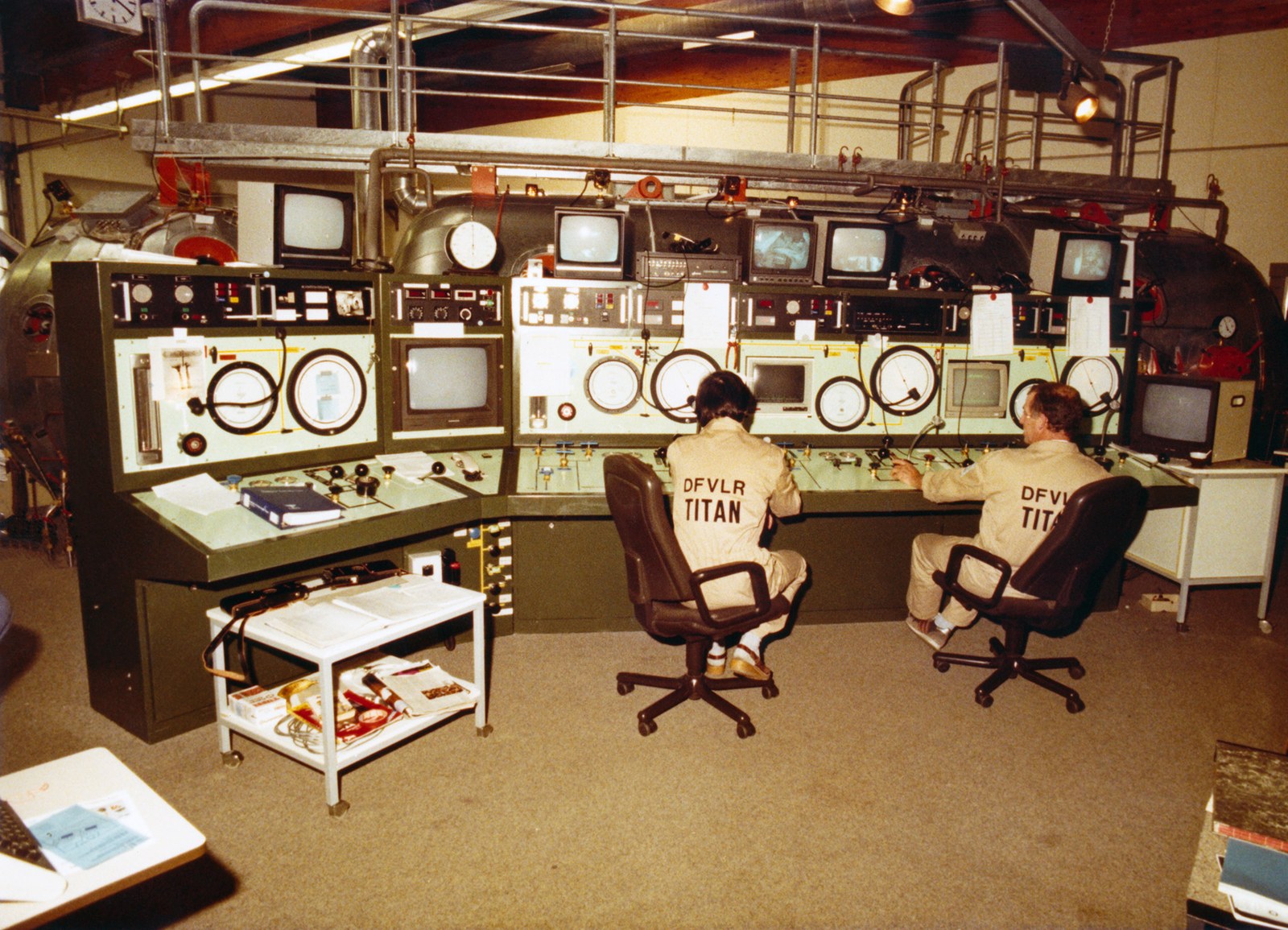Deep diving on dry land


615 metres. The three young divers that reached this depth hold up a sign for photographers on 1 May 1990. It would befour weeks before they were to see sunlight and breathe fresh air again. This record-breaking dive was carried out more than 30 years ago in the DLR TITAN pressure chamber. Entering the water was never necessary – all that was needed were the technology and steel walls of the baromedical laboratory.
Inside TITAN it was possible to create extreme pressure and breathing gas conditions, such as those found at depths of over 600 metres in the North Sea. The use of professional divers for offshore natural gas and oil operations was a hot topic for research at the time. Would it be possible for humans to work on the ocean floor? How would they cope with the extreme pressure conditions? The TITAN chamber and scientists in the then DLR Institute of Aerospace Medicine provided a safe, controlled environment for answering these questions.
"We monitored everything around the clock. It was clear to everyone that we had a great responsibility", says Manfred Schulze (57), one of the technicians who worked on the project. For 40 days and nights, the 'chamber operators' sat at the metre-long control and measurement console. The large control dials, buttons and screens can still be found at the DLR Institute of Aerospace Medicine. Dedicated voice communication systems allowed the team to discuss the tests and their results with the three divers – and every now and then chat about everyday things.
However, as the simulated depth increased, communication became more difficult. The breathing gas used was heliox – a mixture of oxygen and helium – the ratio of which the DLR team continuously adapted to the changing pressure conditions. When diving, helium serves as a substitute for nitrogen, which can cause narcosis at the pressures found in deep dives. However, helium changes the voice, so that it turns into a series of incomprehensible squeaks. "From pressures of around 10 bar at a depth of 100 metres, voice distortion is so strong that divers can no longer communicate with each other verbally", says Frank Weist (60). He was the young diver who held the sign on the twelfth day in the chamber. Communication with the DLR team then took place via an electronic equaliser. Peering into and out of the chamber was possible through a small porthole. So why not simply hold up a piece of paper with information written on it? "Well, beyond 500 metres, our hands were rather shaky," says Weist, reminiscing. Simply picking up a pen and paper was an enormous effort. At a depth of over 600 metres all he wanted was to "sit and breathe, and do nothing else."
"The adaptability of the human body is remarkable"
If divers ascend too quickly, the nitrogen will form small bubbles in their blood vessels and tissue as the water pressure decreases. That is why a suitable decompression rate is vital. The DLR team calculated a decompression time of 28 days for the 615-metre TITAN dive. During this time, the three participants had plenty of tasks to keep them busy, including concentration and performance tests, as well as exercises involving dexterity and balance. Cleaning was also on the schedule – hygiene was extremely important in this environment with its high temperature, pressure and humidity. Any infection or injury would have been a disaster. "We couldn’t simply evacuate the three divers," says diving master Harry Hebborn (83), who was part of the DLR team. "Bringing in a doctor would have taken days as well."
The TITAN pressure chamber is 2.20 metres in diameter and is 6.60 metres long including a wash basin, shower and toilet. From the outside it looks like a spaceship surrounded by measuring devices, pipes and cables. It can accommodate a total of four people. Harry Hebborn and project manager Norbert Luks (69) participated in the selection of the test participants. The most important requirements in addition to their diving experience were their ability to withstand the psychological stress and to get along well with one another. Meals were passed into the chamber through an airlock. Under the extreme pressure, large greasy spots would form on sausages or cheese in seconds. Meat became hard, while puffy desserts arrived as an unappetising mush. "The participants’ sense of taste also disappeared," recalls Norbert Luks.
The dive yielded a wealth of scientific knowledge. "It has been proven that the ability of humans to adapt to extreme environmental conditions is considerable," said a DLR announcement at the time. This is no longer an issue on oil rigs. "Deep-sea operations are now carried out by robots. Back then, however, that was not a possibility," says Luks. The TITAN pressure chamber has not been used for deep dives since 1991, when research funding ended. Since then, work has concentrated on the effects of changes in pressure and atmosphere, for example in aerospace, on mountaineering expeditions and train journeys.
This article was published in DLRmagazine 169
The hyperbaric chamber
The TITAN deep diving simulation facility was commissioned for operation in 1984. It is part of the equipment in the baromedical laboratory at today’s DLR Institute for Aerospace Medicine in Cologne. Diving tests were theoretically possible up to a depth of 1000 metres using the chamber. Pressure ranges between five millibar and 70 bar could be generated within it. This corresponds to the range between a light vacuum and a depth of 700 metres underwater.

